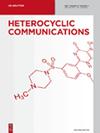新型吡唑-4-甲酰胺的晶体结构和分子对接研究
IF 1.5
3区 化学
Q3 CHEMISTRY, ORGANIC
引用次数: 9
摘要
摘要合成了两种吡唑-4-甲酰胺,3-(二氟甲基)-N-(甲三甲基氨基甲酰基)-1-甲基-1H-吡唑-4-羧酰胺(7a)和3-(二氟甲基)-N-(3,5-二甲基苯基)氨基甲酰基(7b),并通过1H NMR和HRMS分析证实了它们的结构。吡唑-4-甲酰胺7a的结构也通过X射线衍射测定。初步活性结果表明,这两种化合物对灰葡萄孢具有良好的抑制活性。进一步的对接结果表明,关键活性基团是二氟甲基吡唑部分。本文章由计算机程序翻译,如有差异,请以英文原文为准。
Crystal structure and molecular docking studies of new pyrazole-4-carboxamides
Abstract Two pyrazol-4-carboxamides, 3-(difluoromethyl)-N-(mesitylcarbamoyl)-1-methyl-1H-pyrazole-4-carboxa-mide (7a) and 3-(difluoromethyl)-N-((3,5-dimethylphenyl) carbamoyl)-1-methyl-1H-pyrazole-4-carboxamide (7b) were synthesized and their structures were confirmed by the aid of 1H NMR and HRMS analyses. The structure of the pyrazole-4-carboxamide, 7a was also determined by X-ray diffraction. The preliminary activity results demonstrate that these two compounds exhibit good inhibitory activity against Botrytis cinerea. Further docking results indicated that the key active group is difluoromethyl pyrazole moiety.
求助全文
通过发布文献求助,成功后即可免费获取论文全文。
去求助
来源期刊

Heterocyclic Communications
化学-有机化学
CiteScore
3.80
自引率
4.30%
发文量
13
审稿时长
1.4 months
期刊介绍:
Heterocyclic Communications (HC) is a bimonthly, peer-reviewed journal publishing preliminary communications, research articles, and reviews on significant developments in all phases of heterocyclic chemistry, including general synthesis, natural products, computational analysis, considerable biological activity and inorganic ring systems. Clear presentation of experimental and computational data is strongly emphasized. Heterocyclic chemistry is a rapidly growing field. By some estimates original research papers in heterocyclic chemistry have increased to more than 60% of the current organic chemistry literature published. This explosive growth is even greater when considering heterocyclic research published in materials science, physical, biophysical, analytical, bioorganic, pharmaceutical, medicinal and natural products journals. There is a need, therefore, for a journal dedicated explicitly to heterocyclic chemistry and the properties of heterocyclic compounds.
 求助内容:
求助内容: 应助结果提醒方式:
应助结果提醒方式:


